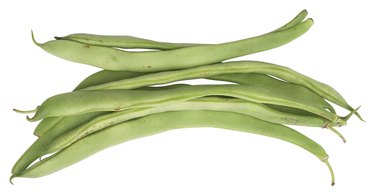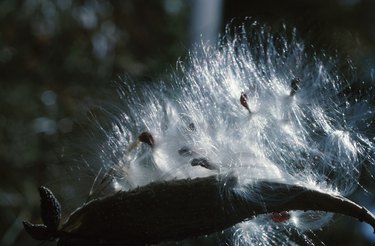
A weed is an unwelcome plant. The term weed usually describes plants that interfere with cultivated areas, such as farms, gardens and lawns. Weeds are invasive and take nutrients and space away from other plants. They often have other undesirable qualities, such as rapid reproduction, thorns or toxins. To identify any plant, know where it grows, its leaf and stem structure, and the type of fruit and seeds it produces.
Birdsfoot Trefoil
Video of the Day
Birdsfoot trefoil (Lotus corniculatus) belongs to the Fabaceae (Leguminosae) family, which also includes peas and beans. It is an alternative to alfalfa for grazing cattle and can be harvested as hay. Considered a weed in turf grasses, it is common across the Great Lakes area of the U.S. and Canada. The plant produces yellow flowers in June resembling buttered popcorn. The seedpods are long and thin, resembling small string beans.
Video of the Day
Dutchman's Pipe Vine
Usually not considered a weed, this plant belongs to the Aristolochiaceae family and grows in the Eastern U.S. and Canada. In the garden, Dutchman's pipe vine (Aristolochia durior) easily overtakes other plants because of its ability to quickly grow and spread. In this way, it displays weedlike traits. Its flowers resemble a tobacco pipe. The seedpods have a beanlike appearance and the leaves resemble the leaves of several other bean species. Dutchman's pipe vine is an important food source for swallowtail butterflies.
Pale Swallow-wort

This plant, also known as European swallow-wort (Cynanchum rossicum), is an invasive weed found in the Northeastern U.S. and Canada. Introduced as an ornamental plant in the mid-1800s, it became problematic on private and public lands. The plant is a persistent vine that wraps around other plants or manmade structures and is difficult to remove. Its seeds are contained in 1- to 3-inch long, beanlike pods and are wind-dispersed in autumn.
Black Swallow-wort
Black swallow-wort (C. louiseae) was introduced to North America with pale swallow-wort. Both species belong to the milkweed family (Apocynaceae) and are similar in appearance. The two swallow-wort species are also collectively called dog strangling vine. Black swallow-wort flowers are dark purple or maroon colored, while pale swallow-wort has lighter flowers. The seedpods of this plant also resemble string beans.
- Michigan State University: Weed List
- Penn State Agronomy Facts; Birdsfoot Trefoil; Marvin H. Hall, et al.
- United States Department of Agriculture: Aristolochia Macrophylla
- Ontario Ministry of Natural Resources; Dog-Strangling Vine; D. Pridham, et a.
- Plant Conservation Alliance Pale Swallow-wort Fact Sheet